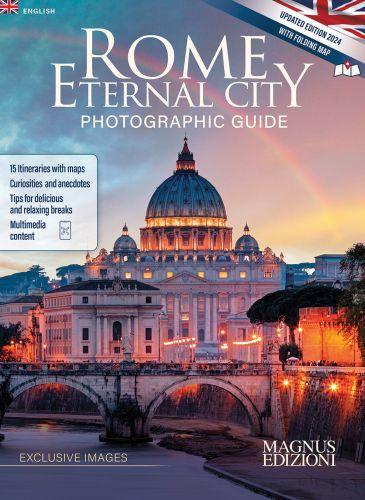

ROME ETERNAL CITY
PHOTOGRAPHIC GUIDE
© Magnus Edizioni 2024
Curated by Emma Mafalda Montella
Editorial director
Federico Ferrari
Editing
Laura Lopardo, Asia Graziano
Layout Gianni Grandi, Roberta Vargiu
Photo credits: © iStock.com: Deniz Unlusu: 4. MasterLu: 5, 70. Fabrizio Troiano: 6, 13. Sjhaytov: 6. Sazonof: 6. Photo Beto: 7, 8, 22, 24, 3, 89, 92, 12. Phooey: 8-9. Samuel Howell: 11. Leochen66: 12. Yves Grau: 12. Neirfy: 14. Jk78: 14. Martin Hosmart: 14
Vladislav Zolotov: 14, 45, 60, 94, 103. Eloi Omella: 15. E55evu: 16, 22, 67. Adisa: 17. Anya Ivanova: 17. Asergieiev: 18. Gollykim: 18 Fotokris: 20. Syhaytov: 22, 52, 73. Perseomed: 23. Julius Fielder: 25, 86. Keff Banke: 32. Fabiomax: 33. SvetlanaSF: 33. Massimo Merlini: 42, 76, 77. Nikada: 42. Grafxart8888: 42. Nicola Forenza: 43, 60. Anna Pakutina: 46. Mikeinlondon: 48. Tshka: 51. Phant: 52, 70. Bernard Bialorucki: 52, 54. Tunart: 52, 56. Pedro Emanuel Pereira: 54. Judith Engbers: 57. Maui01: 60. Benedek: 63. Photooiasson: 67. Oleg Albinsky: 70, 78. Noel Mallia: 71. Frederic Prochasson: 72. Romaoslo: 76, 86, 118. Creativepictures: 78 Luca Mato: 78. Artur Bogacki: 78. Naumoid: 79, 94. Sedmak: 80-81, 98. We-Ge: 81. Starryvoyage: 82. ZU_09: 83. Kevin Miller: 84 Eli Frassens: 85. Walencienne: 86. BRCHphoto: 86. MoT: 86. LedLopezHdz: 87. Stockphoto52: 90. Frankix: 90. Rarrarorro: 91. Borisb17: 92. Arogant: 92. Elxeneize: 93. TravelFlow: 95. Emicristea: 95. Onairda: 96. Trotalo: 97. George Oprea: 97. Caroline Brundle Bugge: 99. VvoeVale: 100. Gun75: 100. StazonovPhoto: 100. Boryak: 100. NYPhotoboy: 103. Francesco Cantone: 109 Massmedia: 111. Marco Piunti: 111. Harald Pizzinini: 112. Valerio Mei: 112, 118, 119, 120. Franco Tognarini: 112, 118. Diego Fiore: 113 Rimbalzino: 115. Gabriele Gelsi: 116. Fabianodp: 118, 123. Misterbike: 120. Cavallapazza: 120. Paolo Gaetano: 125. Wjarek: 125
© Emma Mafalda Montella: 6, 9, 28, 55, 65, 68, 111, 115, 116, 119, 122, 124.
Courtesy of © Studio Cassio - Arte del Mosaico: 8.
Photo © Andrea Jemolo / Bridgeman Images: 7, 10, 64-65, 68, 108
© Magnus Archive: 14, 20, 30, 34, 35, 44, 46, 48, 49, 51, 53, 55, 56, 58, 65, 80, 81, 96, 102, 104, 106, 107, 114, 117
Luisa Ricciarini / Bridgeman Images: 15, 35, 50, 74.
© Ashmolean Museum / Bridgeman Images: 19.
© Magnus Archive / H. Simeone Huber: 21, 30, 54-55, 58, 62.
© Bridgeman Images: 2, 29, 32, 34, 41, 75, 77, 92, 102, 105, 107, 110
© Magnus Archive / Massimo Listri: 26, 27, 28, 42, 47, 59, 60, 66, 69, 75, 88, 98-99, 101, 105
© Copyright Universal Images Group / Bridgeman Images: 42.
Photo © Stefano Baldini / Bridgeman Images: 75. AGF / Bridgeman Images: 116
Photo © Governatorato dello S.C.V – Direzione dei Musei. All rights reserved: Raphael’s Rooms: 22, 36, 37, 38. The Sistine Chapel: 30, 39, 40, 41. Vatican Gardens: 118, 121, 122.
Photo campaigns made by Scripta Maneant – Carlo Vannini, Ghigo Roli, BAMSphoto. Production manager Gianni Grandi. All photographs are the property of Governatorato dello S.C.V. - Direzione dei Musei and protected by copyright (© Governatorato dello S.C.V – Direzione dei Musei. Tutti i diritti riservati).
© Scripta Maneant Group 2024 Via dell’Arcoveggio, 74/2
40129 - Bologna - Italy
Tel. +39 051 223535
Numero verde 800 144 944 www.scriptamaneant.it segreteria@scriptamaneant.it
The Magnus Edizioni brand is owned by Scripta Maneant Group, Bologna, Italy, All rights of reproduction, in whole or in part, of the text or the illustrations, are reserved throughout the world.
ISBN: 978-88-7057-291-9

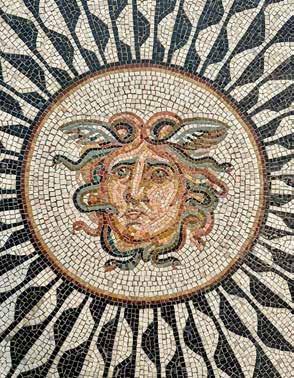

pope Nicholas V allowed artisans and small businesses to be exempted from paying taxes, turning it into what we refer as a “free trade zone”. The situation changed during the Middle Ages when the roman pipelines were out of function and the inhabitants moved to the nearby Campo Marzio. Up until the beginning of the nineteenth century Monti was a green area, with many gardens and scarcely populated due to its long distance from the Tiber, although it remained a crossing point for pilgrims on their way to the Cathedral of Saint John Lateran or the Papal Basilica of Santa Maria Maggiore.
Today Monti is a fascinating and picturesque neighbourhood, full of bars and vintage shops like the Blue Goose and Pifebo. Historically known for its artisanal boutiques, in Monti you’ll find many small businesses specialised in the arts and crafts like jewellery or watchmaking. If you’re in need of repairing an old family watch, Orologeria Verdastro is the right place for you! The store has been making and repairing watches for generations and can bring back to life old heirlooms.

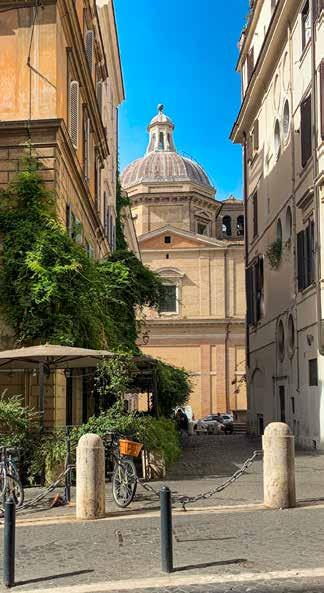
Another interesting laboratory is Studio Cassio in Via Urbana, which specialises in micro mosaic, a special roman technique, and it collaborates with the Vatican Mosaic Study, in order to restore the Vatican mosaics. The place also hosts many formative courses on mosaic art and has recently put in stock plastic pieces, each one conceived with one single plastic bottle, which can be used to realise wall mosaics. A very smart way to make mosaics green and sustainable!
CHURCH OF SANTA MARIA AI MONTI
Also known as Madonna dei Monti or Santa Maria ai Monti > 1.1, the Church can be found in Via dei Serpenti, and its name may come from a picture depicting the Virgin stepping on a snake which was hanged on a wall in the lane. Santa Maria ai Monti is richly decorated with marbles, plasters and frescoes painted by Giacinto Gimignani, Orazio Gentileschi, Antonio Viviani, Lattanzio Mainardi and Paris Nogari. The church’s construction was commissioned in 1580 by Pope Gregory XIII to Giacomo della Porta, in a place where previously stood an ancient monastery of the Poor Clares sisters’ congregation. The sober façade of the building is inspired by the Church of the Gesù, the mother church of the Society of Jesus, and is the second church of the Jesuits present in Rome.
Facing, on the top: Romanesque-style Bell tower that belongs to the Papal Basilica of Santa Maria Maggiore, 1445-1483, 75 metres high.
Facing, below: Polychrome mosaic depicting the figure of a Gorgoneion. Replica by Studio Cassio. The original one is kept in the Roman National Museum of Palazzo Massimo.
At the centre: Interior of the Papal Basilica of Santa Maria Maggiore. The structure is original of the fifth century, but has undergone several changes and renovations over time.
Above: View on the Church of Santa Maria ai Monti, 16th century
On the following page: Mosè, Michelangelo Buonarroti, marble, Basilica of Saint Peter in Chains, 1513-1516.

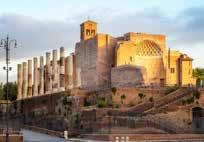
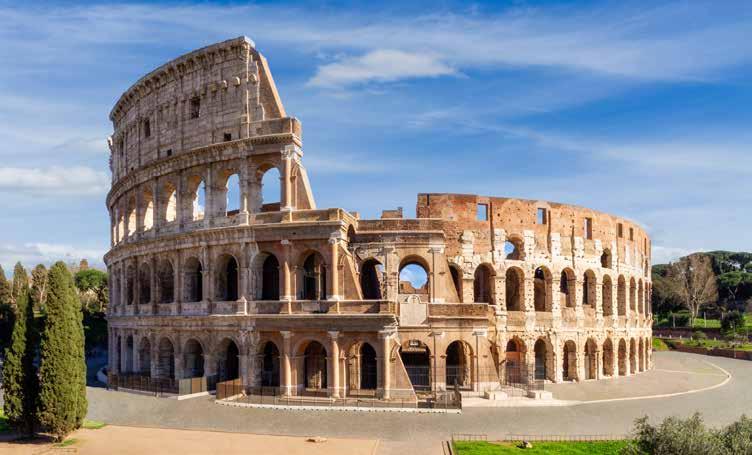
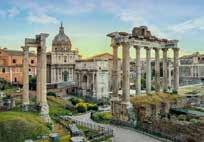
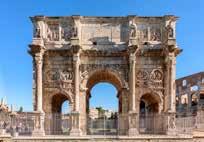

Colosseo
2.2 Capitol Hill
2.1 Imperial Forums
2.4 Arch of Costantine
2.3 Colosseum
2.5 Domus Aurea
2.6 Archbasilica of Saint John Lateran
The monastery and the Basilica of the Four Crowned Martyrs
The Basilica of Saint Clement

From the Imperial Forums to Saint John Lateran
EXTRA CONTENTS
2
Via dei Fori Imperiali > 2.1 is right next to the Capitol Hill > 2.2 and was opened to the public on the 21 of April 1933, when, in order to create the avenue and unearth the ancient roman ruins, the entire area between the Alessandrino Quarter, the Colosseum and Piazza Venezia was demolished and with it its mediaeval and renaissance palazzos. The urban structure of the city centre was altered during fascism, to prioritise the Roman ruins and to glorify them. Although today the area is one of the most important archaeological sites in the world, the destructive operation was the object of many discussions during the twentieth century. Via dei Fori Imperiali owes its name to the ancient roman fora that were brought back to light. The first one was built by Julius Caesar in 54 B.C., followed by the one of Augustus (31 B.C.), of Vespasian (71-75 A.D.), of Nerva (98 A.D), and finally the Trajan Forum (107-113 A.D.). Entirely dedicated to public life, the fora were built at the end of the Republican age. Overlooking the end of the avenue is also the massive Basilica of Maxentius, built at the beginning of the fourth century A.D. on the Velian Hill, the Basilica will be an example for many architects during the Renaissance. Via dei Fori Imperiali is full of life with its street musicians, and at night light effects and projections animate the Imperial Fora, making the atmos-
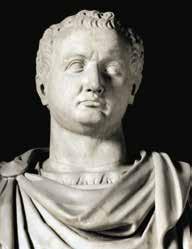
Above: View of the Colosseum.
Below: Bust of emperor Tito Flavio Vespasiano, Capitoline Museums, 9-79 B.C.
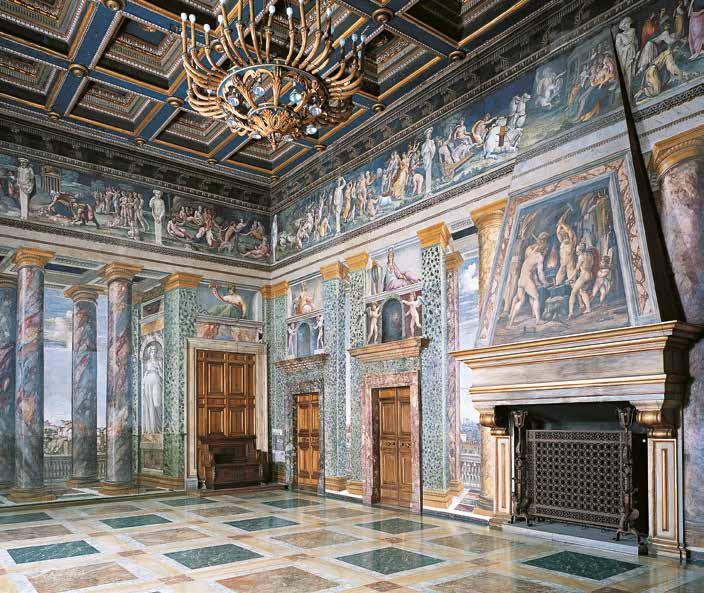
Above: Hall of the Perspectives, Baldassarre Peruzzi and Sebastiano del Piombo, fresco, Villa Farnesina, 1506-1511.
Facing: Loggia of Cupid and Psyche, Villa Farnesina, Raphael, 1506-1511.
PIT STOP
Da Enzo al 29 is one of the restaurants that you must try. Its impeccable reputation draws many tourists every day and the line to get in is usually quite long, but the Cacio e Pepe is definitely worth the wait!
painted by Peruzzi is also striking, with its trompe-l’oeil fresco, one of the first of its kind, anticipating the countryside view beyond the balcony, and the perspective from the fake colonnade is extremely precise. Another famous fresco is the one by Sodoma, who painted the life of Alexandre the Great in the adjoining bedroom on the upper floor. The Galleria Corsini > 3.8 is right across the street from Villa Farnesina, and it hosts part of the Galleria Nazionale d’Arte Antica (along with Palazzo Barberini). The alluring gallery exhibits the works coming from the collection of the Corsini family who bought the palazzo in 1736. The building is also known for having hosted Christina, the Queen of Sweden, in the sixteenth century, who had it entirely renovated by the architect Ferdinando Fuga. Amongst the remarkable works of art exhibited in the gallery there’s the Saint John Baptist by Caravaggio and the Saint Sebastian by Peter Paul Rubens.
ANCIENT PHARMACY OF SANTA MARIA DELLA SCALA
There’s a famous story concerning the Church of Santa Maria della Scala and it involves the well-known Italian artist Michelangelo Merisi, also known as Caravaggio, to whom the church commissioned the painting The Death of the Virgin. The artist finished the canvas in 1606, but the painting was refused by the parish, as it was seen as “unfit” for the church, due to the scandalous position of the dead body of the Virgin. Her ankles and abdomen were swollen, and her body was not as idyllic as it should have been. The
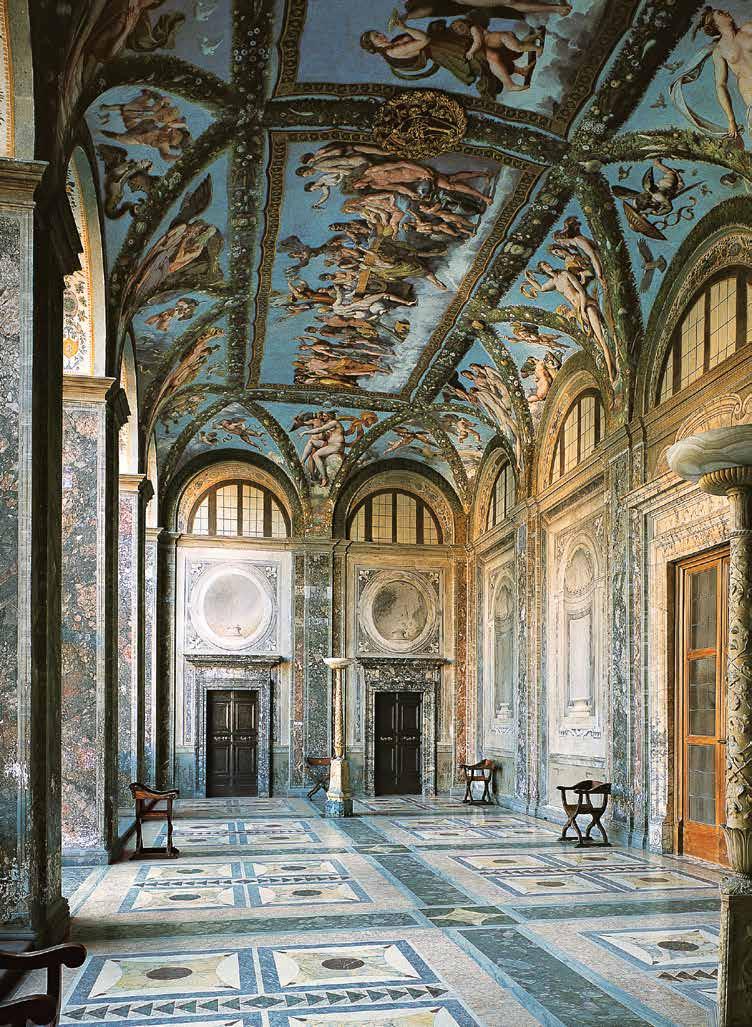

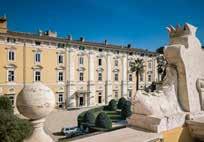
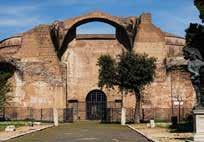
ViadelQuirinale
ViaXXSettembre
ViadelleQuattroFontane
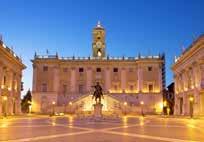
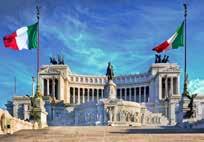
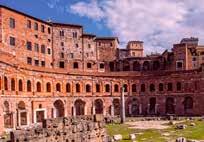
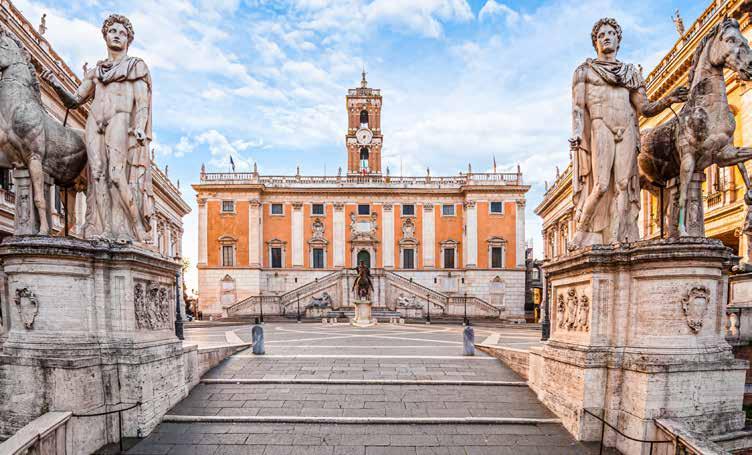
5.3 Church of Santa Maria della Vittoria
5.2 Baths of Diocletian
5.1 Palazzo Massimo
5. 5 Church of San Carlo alle Quattro Fontane
5. 6 Church of Sant’Andrea al Quirinale
5.4 Palazzo delle Esposizioni
5.7 Piazza del Quirinale 5.8 Palazzo Colonna
5.10 Trajan Column
5.9 Trajan Markets
5.11 Vittoriano
5.13 Church of Santa Maria in Aracoeli
5.12 Capitol Hill
The Opera Theatre in Rome

From Termini to Piazza Venezia
ROMAN NATIONAL MUSEUM OF PALAZZO MASSIMO
A few steps away from Termini’s train station, Palazzo Massimo > 5.1 is the Roman National Museum. The building is inspired by the sixteenth century palazzos, but it was only constructed in 1883 as the headquarters of the Jesuit order, following the project of Camillo Pistrucci who had received the commission from the Collegio dei Gesuiti. The palazzo was then purchased by the Italian State in 1960 and converted into a museum. It now boasts a rich archaeological collection like the mesmerising bronze sculpture of the Boxer at Rest, and the white marble Octavian Augustus statue The last floor hosts The Gallery of Paintings and Mosaics, entirely dedicated frescos, stuccoes, and mosaic decorations used in the sumptuous urban and suburban roman residences like Villa di Livia, Villa della Farnesina, Villa di Termini and Villa Pamphili.
BATHS OF DIOCLETIAN, BASILICA OF SANTA MARIA DEGLI
ANGELI E DEI MARTIRI AND MUSEUM OF THE RESCUED ART
The cumulative ticket of Palazzo Massimo also includes the entrance to Palazzo Altemps, Crypta Balbi, the Baths of Diocletian and the Museum of Rescued Art. The Baths of Diocletian > 5.2 are right on the opposite side of the road. The ther-
EXTRA CONTENTS
FUN-FACT
Right next to Palazzo Massimo, on Via del Viminale, you’ll see the now abandoned Casa del Passeggero (literally "House of the Passenger"). Extremely fascinating in its decay, the building was once a day hotel and it closed in the forties. It’s been abandoned ever since but was used as a cinematographic set by Federico Fellini for his movie Intervista, and by Dino Risi for Il segno di Venere.
Above: View of Capitol Square.


The Capitoline Museums are composed by the Palazzo Nuovo and Palazzo dei Conservatori, both restored by Michelangelo. Palazzo Senatorio on the other hand is the emblem of the political palace of the city and was redesigned by Michelangelo under the pontificate of Pope Paulus III. It’s adorned by colossal statues like the one of the Dea Roma Capitolina in the central niche and the other ones which are the personification of the river Nile and Tiber, both recovered from the Baths of Constantine.
The Musei Capitolini are the oldest public museums in the world. Funded in 1471 they’re the main municipal museum structure in Rome. The museum boasts a huge archaeological and modern art collection. Inside you’ll wander amongst wonderfully frescoed halls, like the Sala degli Orazi e Curiazi, where the huge wall fresco painted by Giuseppe Cesari reproduces the battle between the Horatii and Curiatii.
The ancient artworks are placed harmonically along the old fifteenth century halls, like the charming marble and bronze statue of Artemide Efesina. Amongst the best-known statues within the collection are The Equestrian Statue of Marcus Aurelius, the Lupa Capitolina and the Hellenistic group of the Lion Biting the Horse.
The modern art collection includes works by Caravaggio such as the Buona Ventura and the St. John the Baptist, and is divided into different sections: the Mediaeval one, the Renaissance once, the Fifteenth century Ferrarese period, the Fifteenth century Venetian period, the artistic currents between Emilia and
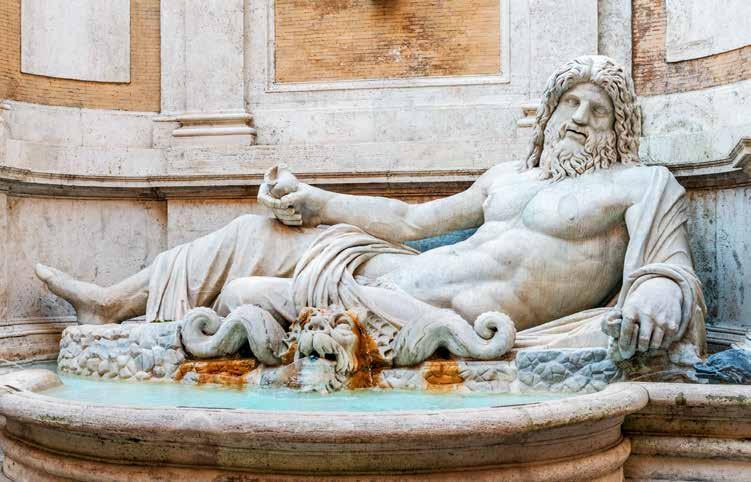
On the top: Buona ventura, Caravaggio, oil on canvas, Capitoline Museums, 1594.
Above: St. John the Baptist, Caravaggio, oil on canvas, Capitoline Museums, 1602.

Rome until the sixteenth century. To better orient yourselves we highly suggest the use of an audio guide or an introductive guide of the collection. At the end of the visit, you should check out the museums’ terrace, which closes at 19.30 and has a breathtaking view over the city. Another less known panoramic spot is the gardens of Piazzale Caffarelli, right in front of the museums, on the Via delle Tre Pile, where you can stay how long you please and bring your own drink to enjoy the sunset.
CHURCH OF SANTA MARIA IN ARACOELI
The last attraction of the itinerary is the Church of Santa Maria in Aracoeli > 5.13, right next to the Capitol Hill. You can access the church by climbing a dizzying staircase of 122 steps at the end of which you’ll be gifted with an amazing view, not for nothing the name Aracoeli literally means “altar of the sky”. It seems like the church is literally suspended in the Roman sky. Inside the Basilica the huge hall is lit up with splendid chandeliers. The church is an expression of mediaeval Rome, with a simple thirteenth century façade made of bricks, erected by Gregorio Magno on the Temple of Giunone Monete. It’s believed that the modern structure was realised by Arnolfo di Cambio for the Franciscan order. In the last few centuries, the whole apparatus was modified, and the inside of the church is now divided into three aisles and contains the famous frescoes by Pinturicchio representing the Funerals of Saint Bernardino, and the Tombstone of Giovanni Crivelli by Donatello.

Above: Statue of Marforio, cloister of the Capitoline Museums, I century A.D.
Below: Bronze statue of the Lupa Capitolina, Capitoline Museums, 490-480 B.C.

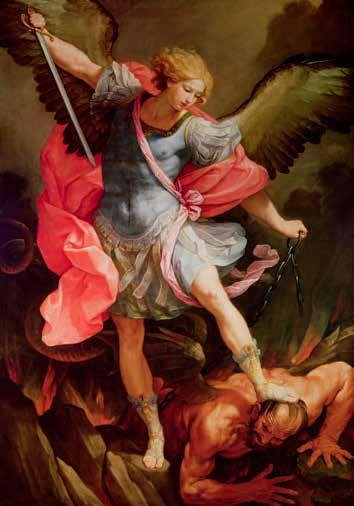
municipal deposit, where it disappeared under undefined circumstances; what we see today is a travertine copy made by Adolfo Apolloni which has replaced the original one in 1916. Vittorio Veneto > 8.4 is the road that connects Piazza Barberini to Porta Pinciana and leads to the gardens of Villa Borghese. The avenue was initially dedicated to the Veneto region but was renamed after the First World War, commemorating the battle of Vittorio Veneto. Extremely popular for being the set of many films, Vittorio Veneto became famous especially thanks to Fellini’s La Dolce Vita. The avenue hosts many fancy hotels and cafes such as Harry’s Bar, the Hotel Majestic, Hotel Balestra, the Palazzo Coppedè, Hotel Excelsior, Palazzo Margherita (the American Embassy), Palazzo Piacentini (the Ministry of the Economic Development) and the Palazzo Marco Biagi (Ministry of Labor and Social Authority).
In the lower part of the street, next to the Fontana delle Api, is the Church of Santa Maria Immacolata > 8.5, founded by Cardinal Antonio Barberini, the younger brother of Pope Urban VIII.
The church was decorated by famous artists such as Pietro da Cortona, who worked on the first chapel on the right, Guido Reni, to whom is attributed the canvas of Saint Michael Archangel, Domenichino and Andrea Sacchi.
The Church is also known for its macabre crypts, where the bones of nearly 4,000 Capuchin friars are exhibited, collected between 1528 and 1870.
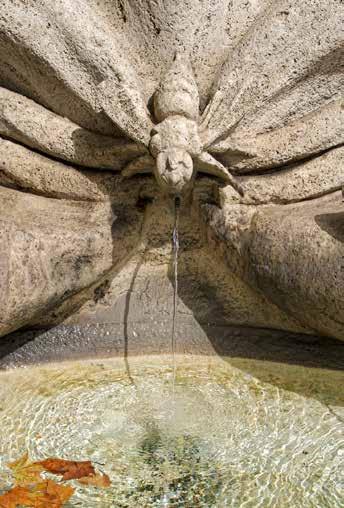
On the top right: Fountain of the Bees, detail, copy of the original, 21 century.
FUN-FACT
Ironically it was right in Palazzo Barberini, residence of popes and princes, that the Socialist Party of Italian Workers was born in 1947 founded by Giuseppe Saragat, following the political split of the reformist wing of the Italian Socialist Party. The event is commemorated in a plaque affixed to the building.
AMBIENCE
If you’re a contemporary art lover (or you just want to snoop around) you can pop by the Gagosian Gallery, located in Via Francesco Crispi, a side street of Via del Tritone. The only Italian branch of the Gagosian galleries, it exhibits works by established artists and, despite its exclusive appearance, anyone can enter and have a look.
On the top left: Saint Michael Archangel, Guido Reni, Church of Santa Maria Immacolata, 1635.
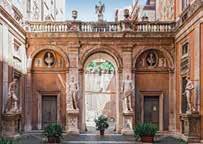
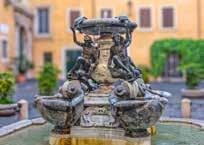
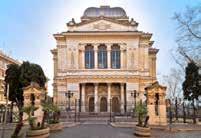
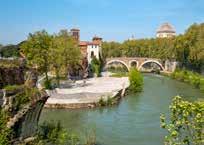
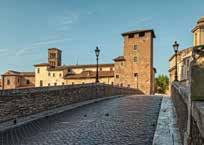
Colosseo
10.2 Palazzo Mattei di Giove
10.1 Piazza delle Tartarughe
10.5 Palazzo delle Cinque Scole
10.3 Porticus Octaviae
10.4 Tempio Maggiore
10.6 Fabricio Bridge
10.7 Tiber Island
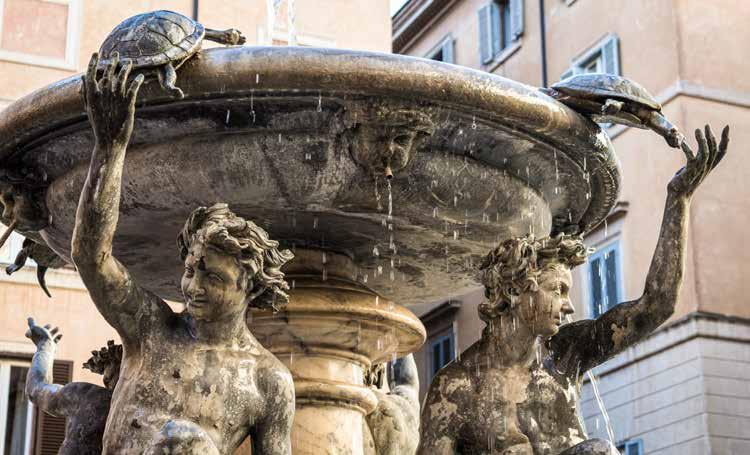
EXTRA CONTENTS
Jewish Ghetto
PIAZZA MATTEI
We find ourselves in Piazza Mattei, also known as Piazza delle Tartarughe > 10.1 with at its center the fascinating Fountain of the Turtles, commissioned to Giacomo della Porta between 1581 and 1588. Legend has it that the duke Mattei, from whom the nearby Palazzo takes its name, lost his family estate gambling, and his future father-in-law prevented him from marrying his daughter. As a response the duke commissioned the fountain, which was realized in just one night, to show off in front of his future wife.
The fountain represents the decorative focal point of the small square, with its rich decorations of shell-shaped basins in polychrome marble and travertine with the refined bronze attributes of ephebes riding dolphins; the turtles were added by Gian Lorenzo Bernini only in 1658.
Originally the fountain was served by the Virgin aqueduct, whose restoration in 1570 made it possible to build a series of fountains in the most populous districts of the city.
Placed in the historic center, Piazza Mattei is isolated from the city traffic and carves out a peaceful space, where you can sip a coffee in the square’s bar Le Tartarughe or have a spritz in the suggestive Bartaruga bistro.
FUN-FACT
The Fountain of the Turtles has a twin sister in the United States. An exact copy of the fountain was commissioned in the early twentieth century by William and Ethel Crocker for the garden of their villa in San Francisco. The heirs of the owners decided later on in 1954 to donate the fountain to the city. The latter was thus placed inside Huntington Park, where it’s still located today.
Colosseo
Above: Fountain of the Turtles, Giacomo della Porta, African marble and bronze, 1581-1588.

FUN-FACT
Inside the Basilica of Santa Sabina in a dark corner you can see the “devil’s stone” (lapis diabli). An ancient legend tells that in the 13th century the stone was hurled by Lucifer himself against San Domenico to lead him into temptation. However, the saint continued with his prayer unbothered. The black marble stone would therefore represent the tangible sign of the legendary event, even bearing the scratches left by the King of the Underworld, who is said to return from time to time to visit that sacred place where he was defeated.
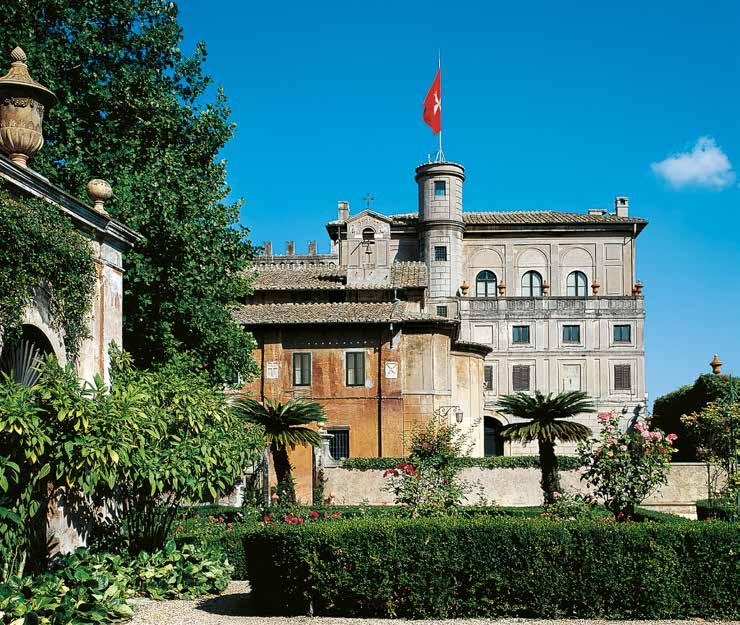
beautiful panorama especially during sunset, with the western side of the hill overlooking the Tiber facing the Gianicolo. In Piazza Pietro d’Illiria is Santa Sabina > 11.8, one of the oldest early Christian basilicas in the city, surrounded by numerous legends and located in a place that is bewitching.
The 5th-century Basilica was built by Pietro d’Illiria, a Dalmatian priest, on a presumed primitive place of worship identified as the Titulus Sabinae, former home of the matron Sabina, and constitutes a model of the first Christian constructive concept that recalls the byzantine prototypes of Ravenna.
Of the very rich mosaics today remains the inscription in gold letters in memory of the builder of the church. The 24 Corinthian columns that divide the naves inside are from the Roman era and the cypress-wood portal has knockers with very ancient representations of the crucifixion carved on.
In the apse is a fresco by Taddeo Zuccari (1560) depicting Christ seated on the mountain surrounded by the sheeps drinking water, while in the atrium there are various materials recovered from the excavations of the church. Through a small circular hole in the wall, you can see the beautiful thirteenth-century cloister, where at its center stands the oldest orange tree in the world. Legend has it that the tree dates back to 1220, when it was planted by San Domenico himself, and over the centuries the tree would sprout again every time it dried up.

The plant, with its miraculous properties, is the mother of all the other orange trees that were planted in the neighboring garden, making the area famous for the production of citrus fruits.
The Aventine Hill is also famous for being the historic seat of the Order of the Knights of Malta where flies a red flag, symbol of the Knights of the very ancient Order, established in 1048 with the aim of assisting pilgrims visiting the Holy Sepulchre. Over the centuries they became more and more influential and powerful and today the Knights remain active, sometimes touring the city with cars with SMOM (Sovereign Military Order of Malta) license plates.
The villa on the Aventine Hill was once a Benedictine convent that belonged to the order of the Templar Knights. The villa also includes the church of Santa Maria del Priorato, decorated with stuccos by Giovanni Battista Piranesi.
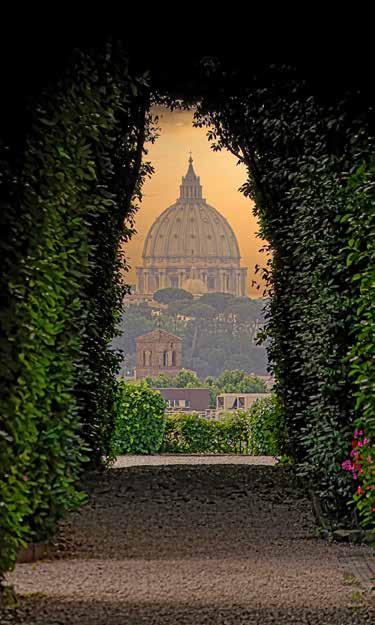
Facing: Annunciation, Taddeo Zuccari, basin of the apse of the Basilica of Santa Sabina, fresco, 1560.
At the centre: Villa del Priorato di Malta, Giovanni Battista Piranesi, 18th century.
Above: Saint Peter’s dome seen from the famous key-hole on the Aventine Hill.
AMBIENCE
The clearing dedicated to the Order of the Knights is one of the most beautiful squares in Rome. The place, surrounded by high walls and gates and punctuated by neoclassical obelisks and stelae conceived by Piranesi, is one of the main attractions of Rome. Indeed, the Priory gate has a famous lock from which, once you look out, you can enjoy the telescopic view of Saint Peter’s dome , theatrically framed by a pergola of trees.
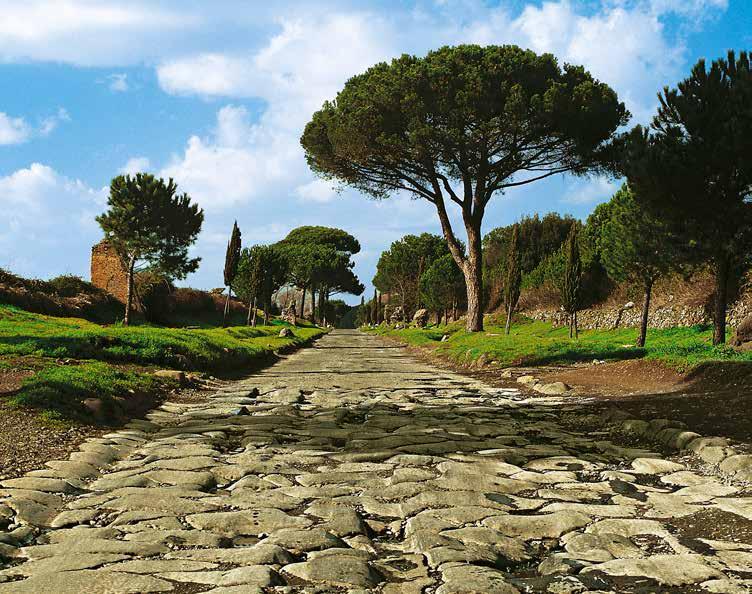
PIT STOP
To refresh yourself after an afternoon spent at the park we strongly advise you to try the nearby Accassadì restaurant, in Viale Opita Oppio 70. The restaurant offers typical and carefully prepared dishes of the Roman cuisine. If you happen to take a walk in the surroundings, you will notice how the neighborhood alternates between modern buildings and older ones and sometimes abandoned small houses. These small abandoned houses were part of the old Quadraro neighborhood and can be spotted at the beginning between Via dei Sulpici and Via Selinunte.
From Via Tuscolana, an ancient medieval road that connected Rome to the territory of Tusculum (today’s Frascati and Grottaferrata), you can go up Via del Quadraro, where you’ll pass the typical local covered market, to arrive at one of the entrances to the large park.
As soon as you get there, it’ll feel like going back in time and you’ll forget you’re in the middle of a city park. In fact, the Park of the Aqueducts, owes its name to the convergence of seven ancient Roman and papal aqueducts, which supplied the city with water and their mighty ruins dominate the landscape.
Seven of the eleven Roman aqueducts met here, the Claudio and Anio Novus, Iulia and Felice aqueducts, and then those of the Tepula, Marcia, Iulia water and the underground aqueduct of Anio Vetus.
Walking through the park, one often comes across flocks of sheep, and, at times, you’ll run into film sets. Numerous directors chose to set their films here, including Federico Fellini and Pier Paolo Pasolini who used the park as the set for their movies La Dolce Vita and Mamma Roma.
The area was transformed into a public park in 1965, but until the 1980s it remained a rather degraded area, with slums and illegal vegetable gardens.
Many displaced people between the 50s and 70s had settled in the area, building illegal settlements between the great arches of the Roman aqueducts, and still today some arches of the Felice Aqueduct in the direction of the adjacent Tor
Above: An ancient paved stretch of the Appian Way.

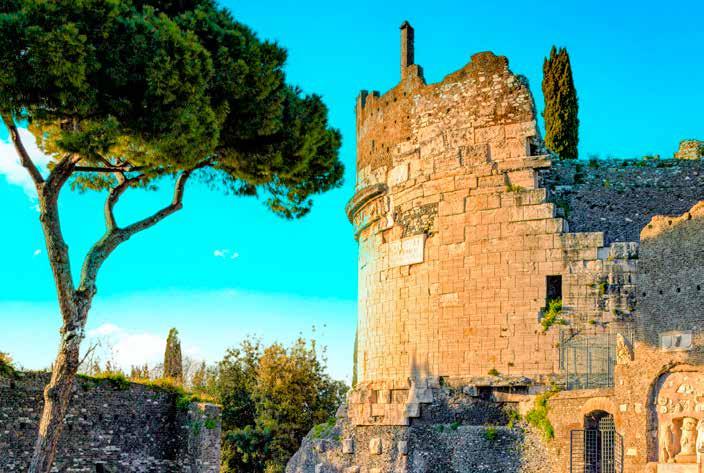
Fiscale Park bear traces of tiles or plaster, reminiscent of the dwellings that had been built within.
The slum survived until the early 1970s, offering refuge to small gypsy communities and immigrant families arriving from southern Italy in search of fortune. Outside the park, if you go on Via dell’Acquedotto Felice, you’ll see the majestic arches of the aqueduct slowly merge with the modern built-up areas, then disappearing in the city traffic.
You’ll notice how the wide green area that seems unexplored at times, was converted in a public park only later on and its structure definitely doesn’t look like the one of a city park with its alternation of narrow streets, meadows and ruins. One always has the feeling of venturing into new places; the landscape can be romantic, but untamed and adventurous at the same time. In the hot Roman summers, the arches will offer you some shade. The gigantic solitary ruins can only give a glimpse of how majestic Rome was. The mighty arches have served various functions over the centuries aside from their original one: the aqueducts have also been plundered and used as building material and are a perfect example of how everything in Rome has had multiple functions over the centuries, adapting to new eras. This is the charm that reigns in the “eternal city”.
ANCIENT APPIAN WAY
Fascinating and definitely well-known is the tour of the ancient Appian Way . Called Regina Viarum by the Romans, the road started from Porta San Sebastiano > 14.2 , located close to the Baths of Caracalla, to reach Brindisi. It was only completed in 190 B.C., but the first kilometers were started in 312 B.C. Commissioned by the censor Appio Claudio Cieco, the builder of the first

On the top: Mausoleum of Cecilia Metella, I century B.C.
Above: One of the ancient arcades of the roman aqueducts, Park of the Aqueducts.
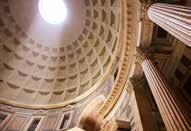
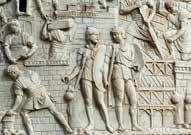

Experience the authentic essence of Rome.
‘Rome Eternal City’ is the first in a series of photographic guides dedicated to discovering the cultural heritage and artistic treasures of Italy’s main art cities.
Unusual and evocative itineraries, historical anecdotes, artistic curiosities and gastronomic tips.
QR codes to access extra multimedia contents that delve deeper into the places recommended in the itineraries and offer further suggestions for visits.
Museums, galleries, churches and monuments not to be missed.
Archaeological areas, fountains and obelisks to discover the glorious past of the Urbe.
Squares to cross and neighbourhoods to walk through to savour the city bustle of the capital.
Green areas and quiet corners where you can find refreshment.
An unprecedented and complete immersion in the beauty of the Eternal City, thanks to the rich corpus of exclusive images and extra contents.
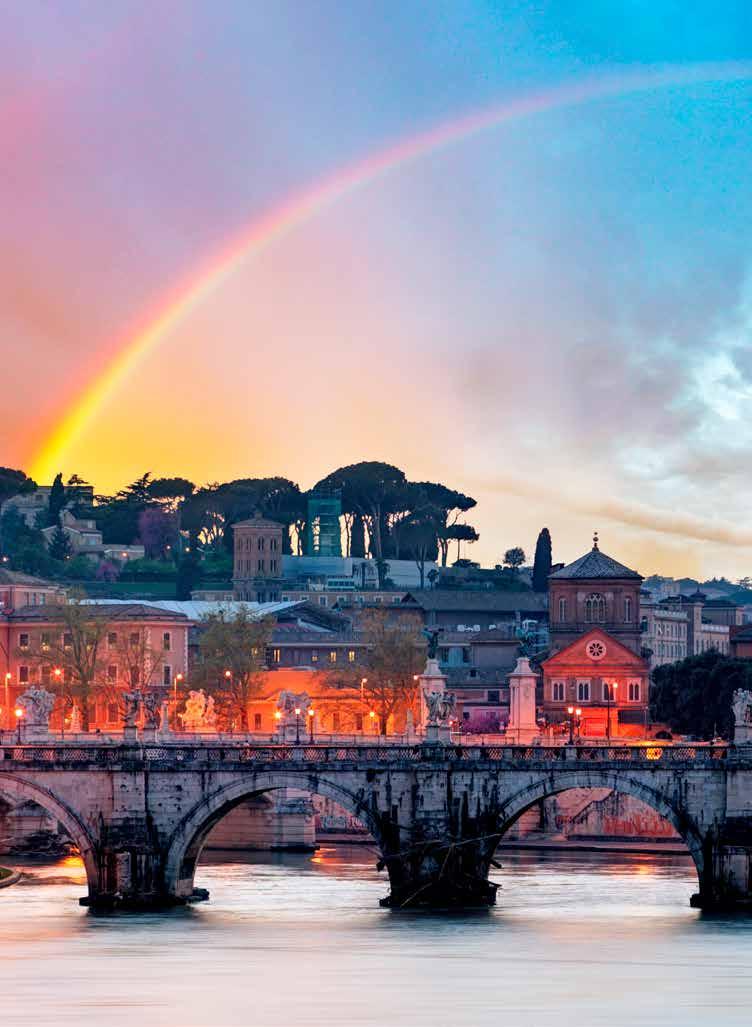

Magnus Edizioni is a brand Scripta Maneant Group
